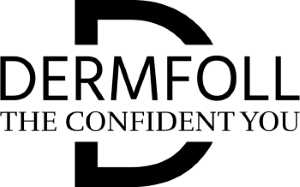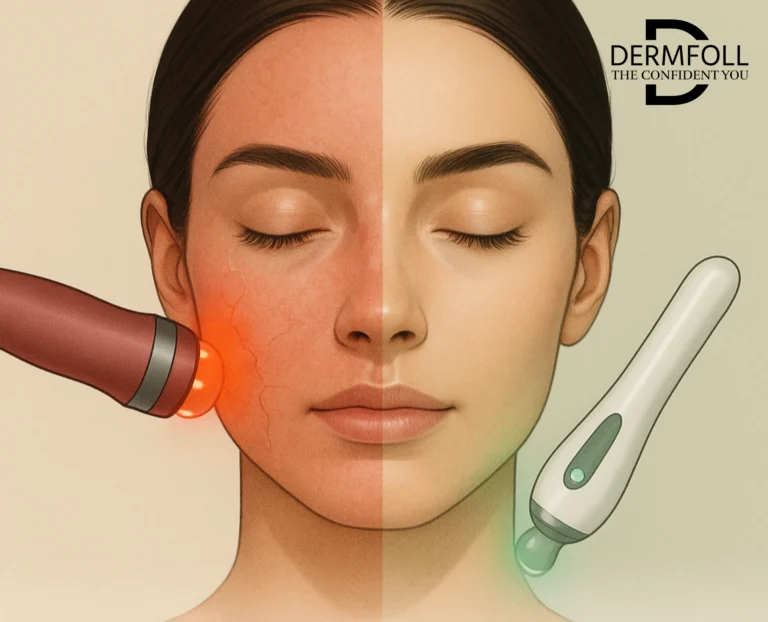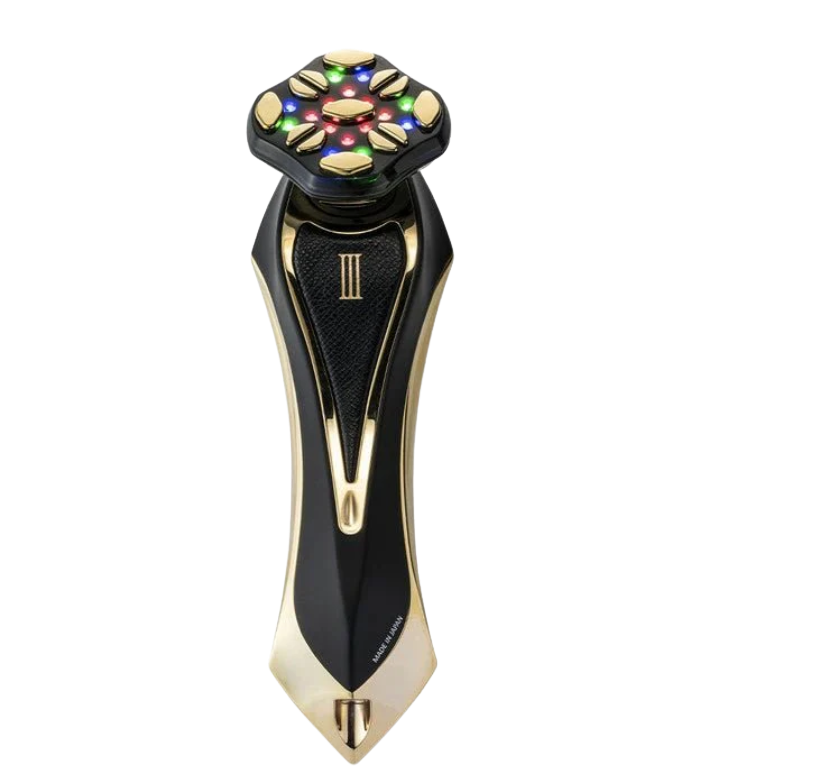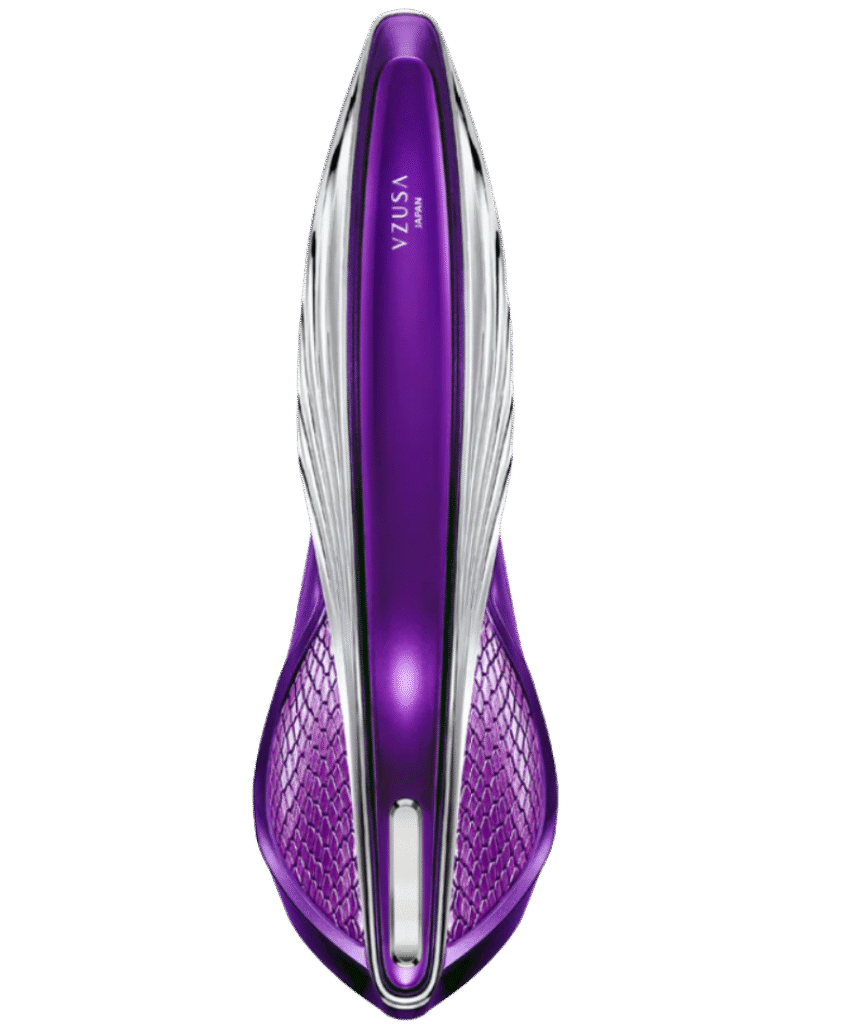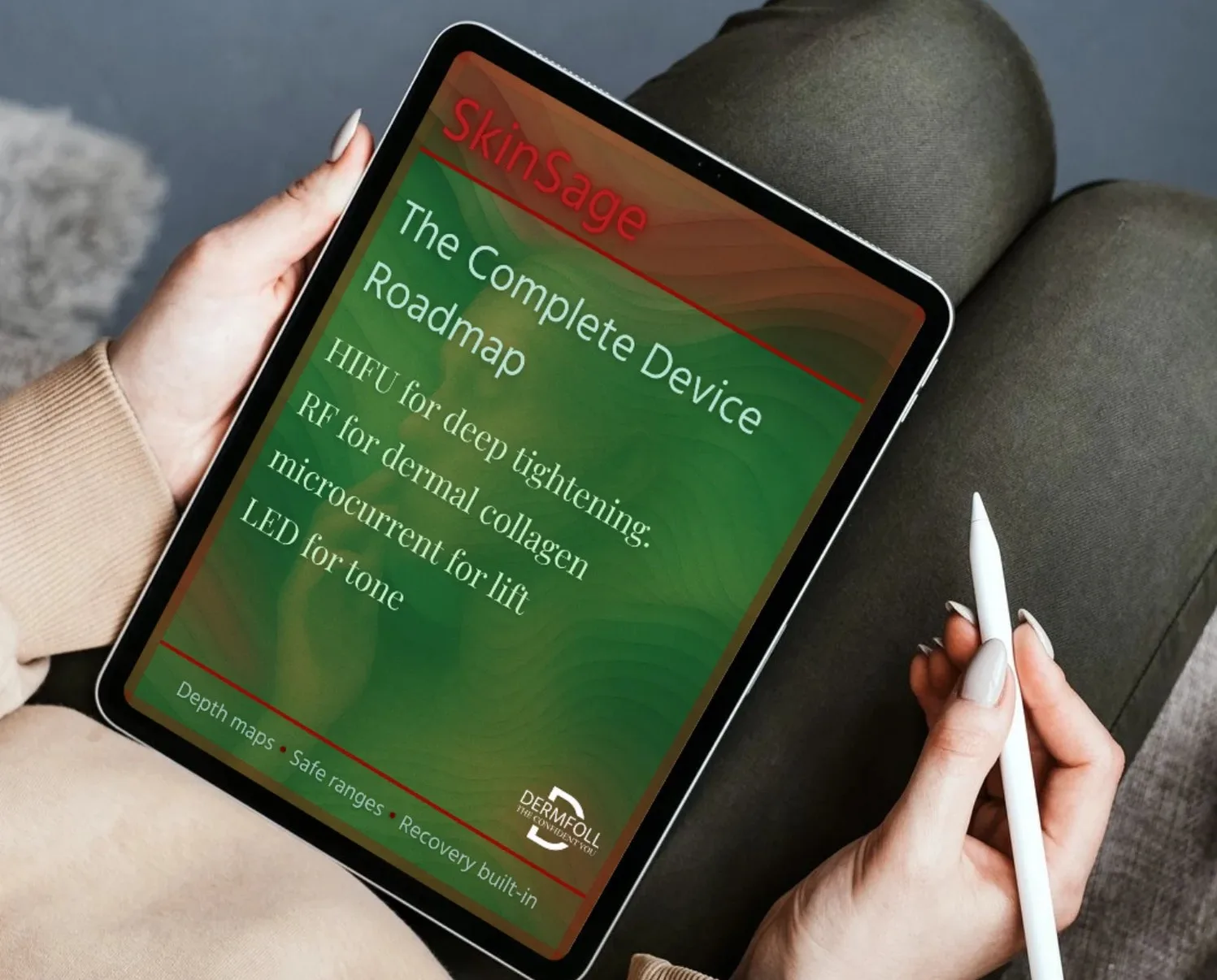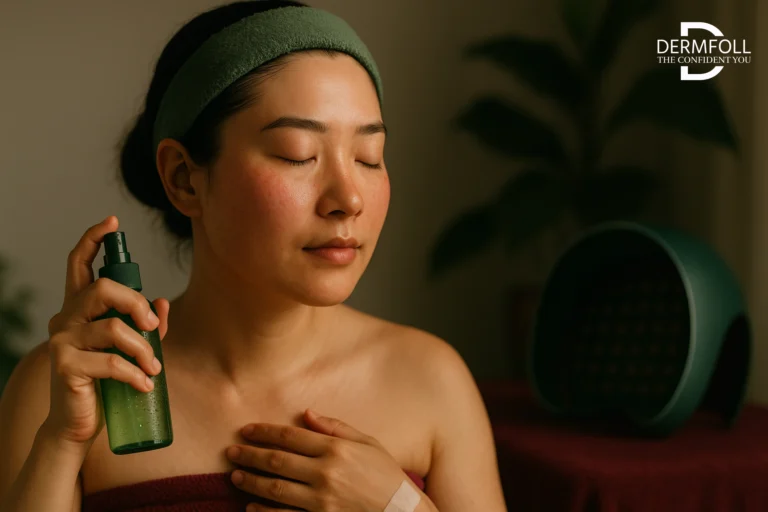Understanding Sensitive Skin: Microcurrent vs Radio Frequency
Okay, let’s unpack this together, because if your skin flares up easily, even from things that seem harmless. There’s more going on than just “delicate skin.”
It’s not just in your head or your imagination. Your skin’s barrier function – its natural defense system, is doing a lot of the heavy lifting, and when it’s out of balance, things can go haywire pretty quickly.
The Role of Barrier Dysfunction in Skin Reactivity
Picture your skin barrier like a brick wall. The “bricks” are your skin cells, and the “mortar” that holds them together? That’s made up of lipids – specifically ceramides, cholesterol, and free fatty acids.
When these lipids are present in the right ratio (roughly 50:25:15, ceramides being the MVP here), your skin stays hydrated, smooth, and protected.
But when that balance is off – like when ceramides are low or fatty acids are depleted – the wall starts to crack.
A key observation from one dermatologic study really stood out:
“Disrupted ceramide synthesis and altered lipid ratios correlate directly with impaired barrier function and increased sensitivity to topical and low-level energy treatments.”
So when the lipid structure is compromised, it’s not just about dryness – it’s a full-on cascade of heightened reactivity.
Neurogenic Inflammation and the Epidermal Nerve Network
Now, let’s go even deeper – literally. Beneath your skin’s surface is a dense network of tiny, unmyelinated nerve endings. In sensitive skin, these nerves tend to be more active, more alert… more on edge.
So when your barrier is compromised and the skin is inflamed, these nerves send out chemical distress signals – mainly substance P, calcitonin gene-related peptide (CGRP), and through receptors like TRPV1.
That’s when you start feeling that warm flush, prickly itch, or stinging – even if nothing looks visibly “wrong.” It’s your nervous system doing a little too much.
Now, here’s the catch: treatments that use thermal energy, like radiofrequency or even low-grade electrical currents from microcurrent therapies, can sometimes excite these nerves further.
And if your barrier’s already weak? That reaction might be amplified.
According to a review on reactive skin physiology:
“TRPV1 and substance P signaling are significantly elevated in patients with neurogenic inflammation, often intensifying responses to even subthreshold thermal or mechanical stimuli.”
So if you’ve ever said, “Why does my skin freak out when I haven’t even done anything harsh?” – this might be the real answer.
Microcurrent Therapy: How It Works on Skin and Nerves
Let’s talk microcurrent therapy. If you’ve ever used a face lift machine at home or considered one, you’ve probably heard that microcurrent is “like exercise for your face.” But what does that actually mean for your skin—especially if it’s on the sensitive side?
Impact on the Superficial Musculoaponeurotic System (SMAS)
Microcurrent doesn’t just work on the skin – it also targets the SMAS, a layer of tissue that connects your facial muscles to the skin above. This is the same layer surgeons manipulate during a facelift.
Microcurrent tones these muscles by improving their strength and responsiveness. Which can subtly lift and contour the face over time – without heat, needles, or downtime.
Think of it as Pilates for your face: low impact, high reward.
Radiofrequency Devices: Mechanism, Heat, and Inflammation
Let’s get into radiofrequency (RF), a go-to for tightening and lifting, and often discussed in the microcurrent vs radio frequency conversation.
It’s effective, but it works very differently from microcurrent. And if you have sensitive skin, there’s a bit of nuance you should know.
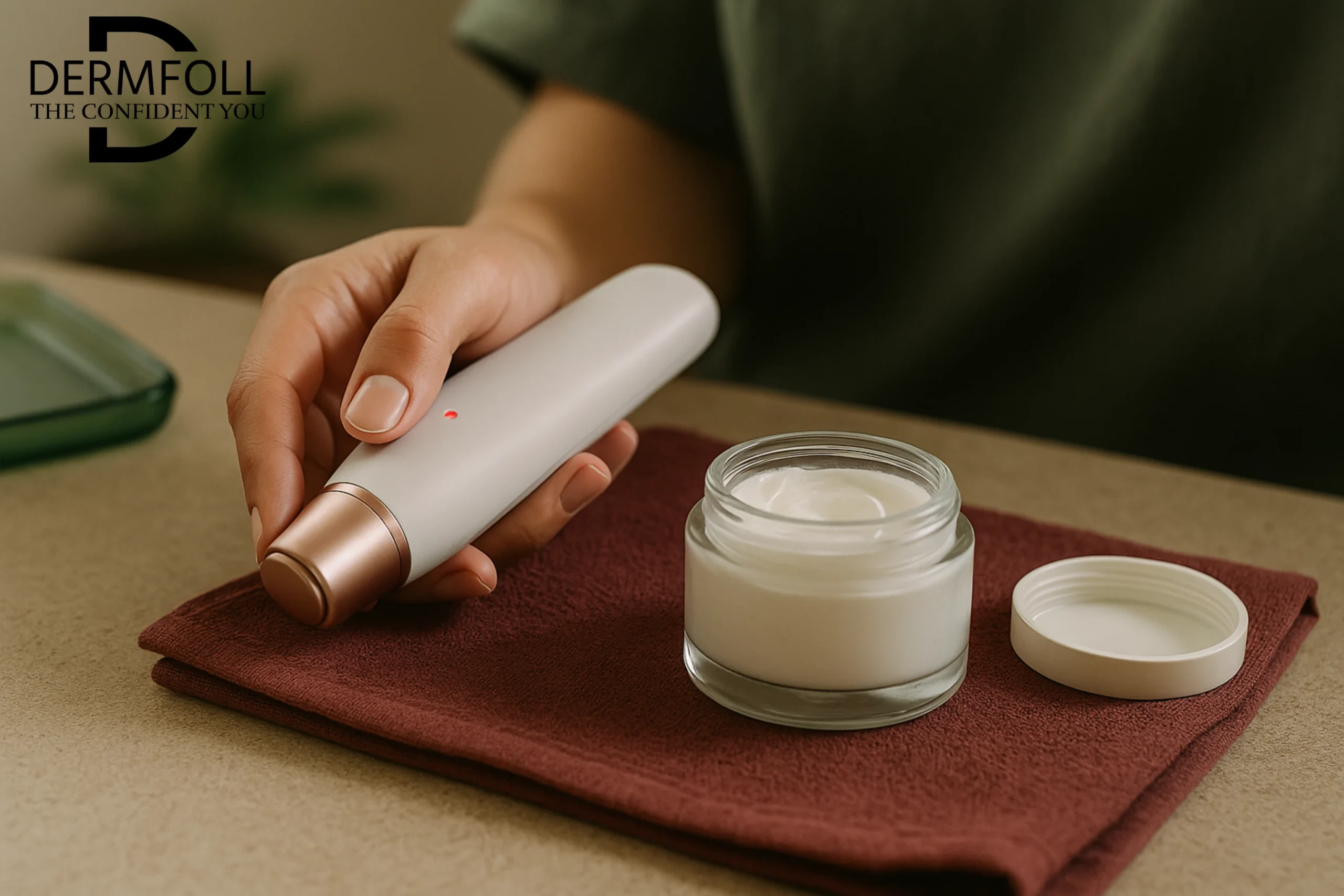
Controlled Thermal Injury: The Double-Edged Sword of RF
RF works by heating the deeper layers of your skin, especially the dermis, where collagen lives. That heat stimulates fibroblasts to create new collagen and elastin – essentially helping your skin rebuild itself. It’s a controlled form of thermal injury that’s actually meant to heal.
Now here’s the twist: for some sensitive skin types, that heat can be too much. Barrier-compromised skin might respond with redness, tingling, or prolonged warmth. A review of device-based therapies put it simply:
“Dermal thermal stimulation activates fibroblasts but may also increase pro-inflammatory cytokines in barrier-impaired skin.”
But it’s not always bad news.
A recent clinical study compared radiofrequency with pulsed dye laser in patients with rosacea, including both erythematotelangiectatic (ETR) and papulopustular rosacea (PPR).
Surprisingly, RF performed just as well – if not better – in patients with PPR, reducing inflammation, lesion count, and erythema over just three sessions.
So while RF might provoke sensitivity in some, it can also offer meaningful relief for others. It all depends on what kind of “sensitive skin” you’re dealing with.
Comparing Treatment Depth: Dermis vs. SMAS in Sensitive Skin
When you’re exploring facial electrical treatments, one question that rarely gets enough attention is: how deep is this device going? And it matters – a lot – especially if you have sensitive or reactive skin.
Some devices are designed to treat the dermis, while others aim for deeper layers like the SMAS (that’s the Superficial Musculoaponeurotic System).
Understanding the difference can help you make more thoughtful choices – and avoid unnecessary irritation.
Why SMAS-Level Targeting May Be Gentler for Surface-Reactive Skin
The SMAS sits beneath your skin and subcutaneous fat, closer to where your facial muscles live. It’s the layer surgeons lift during a facelift.
Some energy-based devices like certain high-intensity microfocused ultrasound systems and, in gentler ways, microcurrent therapy – can reach this level without disturbing the more reactive top layers.
That’s a big deal if your skin gets angry easily.
Because in this debate of microcurrent vs radio frequency, These two devices behave differently, this distinction matters: microcurrent targets the SMAS through electrical stimulation without heat or trauma.
It tones and lifts subtly but safely, making it a smart choice for sensitive types who still want visible results without surface inflammation.
When Dermal Remodeling Is Risky: Depth Matters in Inflammation
Now contrast that with RF devices that focus more on the dermis – the collagen-rich middle layer just beneath the surface.
While this is great for stimulating collagen production, fractional RF or superficial RF treatments also pass through the epidermis, where most of your skin’s sensory nerves and immune triggers reside.
And here’s the challenge: in skin that’s not so resilient – like barrier-damaged or rosacea-prone skin. This superficial energy can provoke erythema, burning, or delayed-onset inflammation.
According to structural analysis from cosmetic dermatology research:
“Superficial thermal interventions in epidermally sensitive individuals pose a higher risk for prolonged post-treatment erythema due to neurovascular and barrier disruption.”
So the depth isn’t just about what’s most effective – it’s about what your skin can actually handle.
The bottom line? If your skin flares up easily or has been through a lot, going deeper with a low-impact approach – like facial electrical treatments or carefully calibrated SMAS-targeting devices may actually be the gentler route.
| Feature | Microcurrent | Bipolar RF |
|---|---|---|
| Penetration Depth | 0.5 – 1.0 mm | 2 – 4 mm |
| Target Layer | SMAS, superficial muscles | Mid-to-deep dermis |
| Risk in Sensitive Skin | Very Low | Moderate (especially in barrier-impaired skin) |
| Common Reactions | Mild tingling or temporary fatigue | Redness, warmth, occasional swelling |
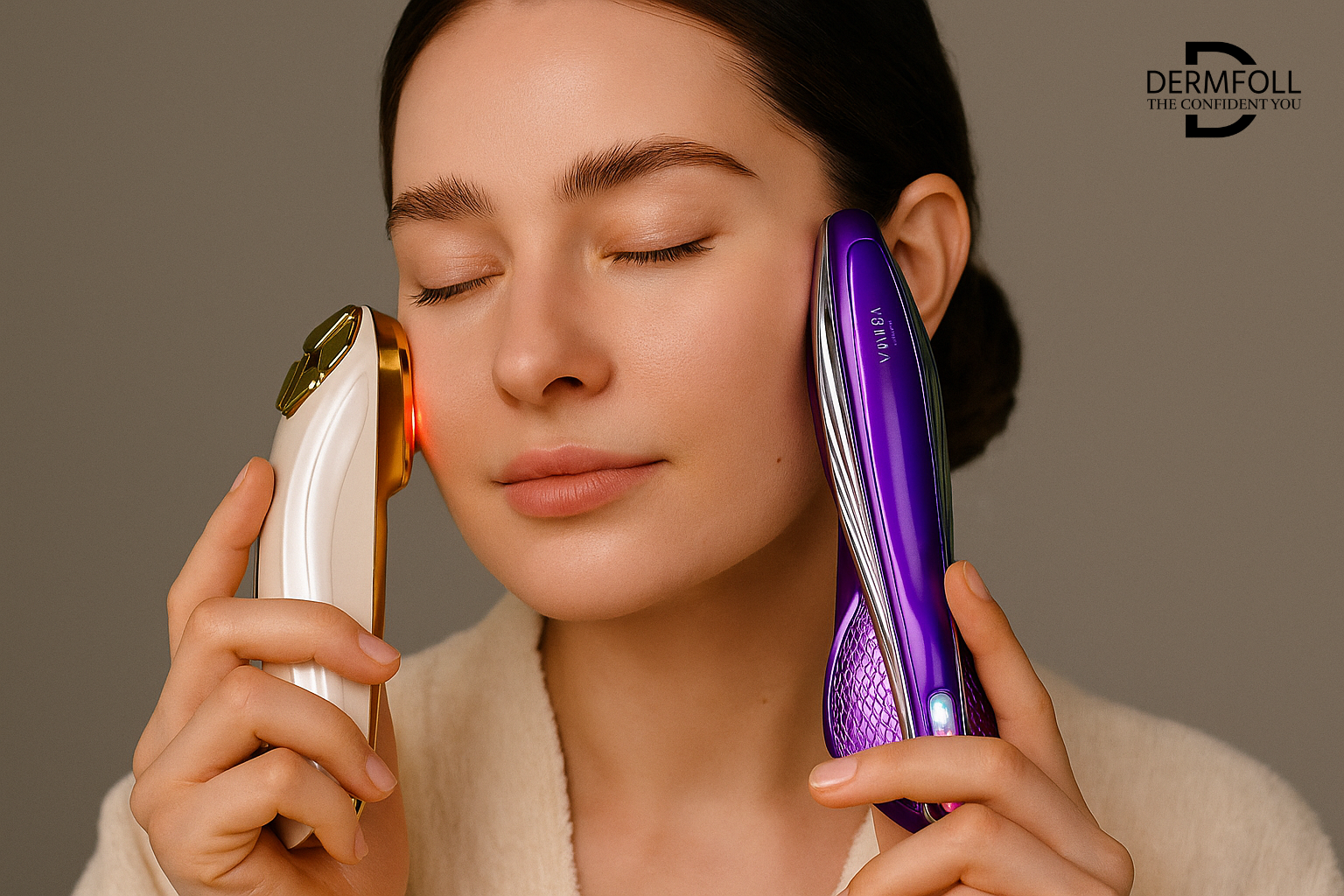
Picking the Right At-Home Device: Where & Why to Buy
“Electroporation has been shown to boost absorption depth and speed by over 200%.”
Choosing between Facial Electrical Treatments often comes down to your skin’s needs and how hands-on you want to be.
Let’s look at the Dr Arrivo THE ZEUS III, an all-in-one marvel that combines microcurrent, EMS, and RF – perfect if you’re exploring Microcurrent vs Radio Frequency at home.
All-in-One Powerhouse: Dr Arrivo THE ZEUS III
Why You’d Choose It
- Full-Spectrum “Lift + Warmth”: Switch between TP, HP, and DF modes to blend microcurrent, EMS, and RF in a single session.
- Sensitive-Skin Friendly: Skip the heat on reactive days – use zero-heat microcurrent/EMS – then ramp up RF only when your barrier feels strong.
- Enhanced Serum Uptake: The Insertion Pulse feature nudges your serums deeper without cranking the temperature.
Pros & Cons
- Pros:
- Ultimate flexibility – use just microcurrent/EMS or add RF warmth as you like
- Compact and lightweight (205 × 60 × 66 mm; 186 g)—easy to handle during your routine
- Insertion Pulse boosts topical efficacy, letting you rely on gentler settings
- Cons:
- Three distinct modes mean a bit of a learning curve
- Higher price point than single-modality tools
- Needs regular charging and careful cleaning of those silicone contacts
Key Considerations
- U.S. support via MYERNK, with an English manual and a 12-month limited warranty
- Perfect if you want one device that evolves with your skin’s tolerance and your treatment goals
Pure Microcurrent Focus: THE VZUSA II
“Electroporation increases cosmetic absorption depth and speed by more than 200%.”
If you’re leaning into Facial Electrical Treatments but want to skip the heat entirely, THE VZUSA II is a standout choice. It zeroes in on microcurrent and boosts your serums – without any thermal risk.
Why You’d Choose It
- 100% Non-Thermal Lift MFIP microcurrent pulses and gentle Shiatsu-style vibration tone the SMAS layer (that’s your muscle lift layer) without warming the skin.
- Customizable Booster The electroporation (“UP”) mode drives serums deep, while tri-color LED (red for collagen, green for tone, blue for calm) layers in extra skin-soothing benefits.
- Ultra-Gentle No RF heat means minimal risk of flares—perfect if you’ve got reactive or barrier-compromised skin.
Pros & Cons
- Pros:
- Zero thermal load – no heat-induced redness or sensitivity spikes
- Multiple waveforms let you dial intensity up or down like a DJ mixing tracks
- Built-in LED adds anti-inflammatory and tone-evening power
- Cons:
- Desktop-style setup – not quite as grab-and-go as a handheld
- Higher upfront investment (~$2,065 USD)
- Needs its own spot and power hookup on your home “beauty station”
Key Considerations
- Ships stateside through the ARTISTIC&CO importer, complete with English UI and manual
- Ideal if you want a dedicated home setup that focuses purely on non-thermal microcurrent lift
Quick Comparison & Decision Guide
Navigating the world of Facial Electrical Treatments comes down to two big decisions: how many tools you want in one device, and where you plan to use it. Let’s break it down:
- Mode Flexibility vs. Purity
- Zeus III puts the power in your hands—mix microcurrent, EMS, and RF whenever you like. It’s your Swiss Army knife of skincare.
- VZUSA II sticks to the non-thermal lane: pure microcurrent, electroporation, and LED. No heat. No fuss.
- Portability vs. Stationary Use
- Zeus III is a true handheld—toss it in your bag for weekend getaways or desk-to-dinner glow.
- VZUSA II shines at home on your dedicated beauty counter—robust, feature-packed, and ready whenever you are.
Decision Guide
| Feature | Dr Arrivo THE ZEUS III | THE VZUSA II |
|---|---|---|
| Use Case | Full-face anti-aging and lifting sessions | Pure microcurrent toning and serum infusion |
| Best For | All-in-one Facial Electrical Treatments that grow with your skin | A zero-heat Microcurrent vs Radio Frequency approach for reactive skin |
| What to Expect | Noticeable lift, firming, collagen boost, and soothing warmth | Gentle muscle tone, deeper serum absorption, and clearer skin tone |
| Price → Result | 4 / 5 | 4 / 5 |
| Tech Used | TP & HP microcurrent, EMS, DF RF, and LED | MFIP microcurrent, UP electroporation, and tri-color LED |
CONCLUSION
So, what we learn?
And that’s the heart of the Microcurrent vs Radio Frequency debate—picking a device based on how your skin feels, not just the promise of results.
I know it can be confusing when every gadget claims “lift,” “tone,” or “tighten.” But your skin’s comfort is the real compass.
Whether you gravitate toward the all-in-one flexibility of the Dr Arrivo THE ZEUS III or the gentle precision of THE VZUSA II, understanding how each technology interacts with your barrier and nerves will guide you to the best fit.
There’s no one-size-fits-all answer. The more you learn about how these Facial Electrical Treatments work with your unique skin, the more confident—and comfortable—you’ll feel every step of the way.
In our next post, we’ll go even deeper – literally. 🙂
We’ll explore how moisture loss, barrier repair, and device depth affect not just your results but your skin’s recovery.
If you’ve ever wondered why some treatments feel amazing and others leave you red and tight, you won’t want to miss this one.
